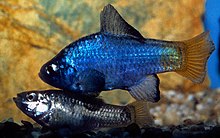This article needs additional citations for verification. (May 2016) |
| Pupfish | |
|---|---|

| |
| Desert pupfish (Cyprinodon macularius) | |
| Scientific classification | |
| Domain: | Eukaryota |
| Kingdom: | Animalia |
| Phylum: | Chordata |
| Class: | Actinopterygii |
| Order: | Cyprinodontiformes |
| Suborder: | Cyprinodontoidei |
| Family: | Cyprinodontidae T. N. Gill, 1865 |
| Genera | |
|
See the text | |
Pupfish are a group of small killifish belonging to ten genera of the family Cyprinodontidae of ray-finned fish. Pupfish are especially noted for being found in extreme and isolated situations.[1] They are primarily found in North America, South America, and the Caribbean region. As of August 2006, 120 nominal species and 9 subspecies were known. Several pupfish species are extinct and most extant species are listed. In the U.S., the most well-known pupfish species may be the Devils Hole pupfish, native to Devils Hole on the Nevada side of Death Valley National Park. Since 1995 the Devils Hole pupfish has been in a nearly steady decline, where it was close to extinction at 35–68 fish in 2013.[2]

The common name is said to derive from the mating habits of the males, whose activities vaguely resemble puppies at play;[3] Carl L. Hubbs, a prominent ichthyologist and one of the first people to take an interest in them, coined the name after he observed their "playful" circling and tussling, which is actually the aggressive behavior of territorial males.[4][5]

In spite of their name, the cyprinodontids are not closely related to Cyprinidae, or carp family. They were formerly considered near allies of the pikes and their relatives, as they share some features: a flat head with protractile mouth beset with cardiform, villiform, or compressed, bi- or tricuspid teeth, generally large scales, and the absence of a well-developed lateral line. However, they are now generally assigned to the order Cyprinodontiformes. Several forms occur in the fossil records of the Oligocene and Miocene beds of Europe.[6] Pupfish from San Salvador Island were able to diversify into multiple species with different eating habits due to interbreeding with pupfish from other islands, mainly Caribbean.[7]
Most pupfish are inhabitants of fresh and brackish waters. Many species are ovoviviparous; often the sexes are dissimilar, the female being larger and less brilliantly coloured, with smaller fins; the anal fin of the male may be modified into an intromittent organ by means of which internal fertilization takes place.[6] Most pupfishes' diet consists, mainly, of algae, decaying vegetation, and any insects they can get.
- ^ McGinnis, Samuel M. (2006). Field Guide to Freshwater Fishes of California (Revised ed.). University of California Press. p. 271.
- ^ Beissinger SR. 2014. Digging the pupfish out of its hole: risk analyses to guide harvest of Devils Hole pupfish for captive breeding.
- ^ Berra, Tim M. (2001). Freshwater Fish Distribution. Academic Press. p. 348.
- ^ Moyle, Peter B. (2002). Inland Fishes of California. Berkeley, California: University of California Press. pp. 326–239. ISBN 0-520-22754-9.
- ^ Barlow, George W. (1961). "Social behavior of the desert pupfish, Cyprinodon macularius, in the field and in the aquarium". American Midland Naturalist. 65 (2): 330–359. doi:10.2307/2422959. JSTOR 2422959.
- ^ a b One or more of the preceding sentences incorporates text from a publication now in the public domain: Boulenger, George Albert (1911). "Cyprinodonts". In Chisholm, Hugh (ed.). Encyclopædia Britannica. Vol. 7 (11th ed.). Cambridge University Press. p. 695.
- ^ "San Salvador pupfish acquired genetic variation from island fish to eat new foods". ScienceDaily. 10 August 2017. Retrieved 1 September 2017.